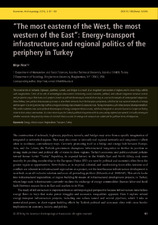| dc.description.abstract | The construction of railroads, highways, pipelines, tunnels, and bridges is a result of an imagined construction of regions and in return helps solidify such imaginations. Critics of the role of technological advancement in fostering social, economic, political, and cultural integration between centers and peripheries argue that many such projects remain as political dreamscapes instead of serving as successful examples of transregional integration. Nevertheless, new political dreamscapes give way to new client networks from the European peripheries, solidified by real material networks of energy and transport. Currently promoting itself as a bridge and energy hub between Europe and Asia, Turkey champions such infrastructural developmentalism. This article examines how some political dreamscapes of energy-transport infrastructures, which are imagined to connect Eurasia to Europe via Turkey,
relate to their actual construction. At a time when hopes for Turkey’s political integration with its surrounding regions have waned, I critically interrogate whether economic integration by means of material infrastructures for energy and transport can substitute for political forms of integration. | en |


